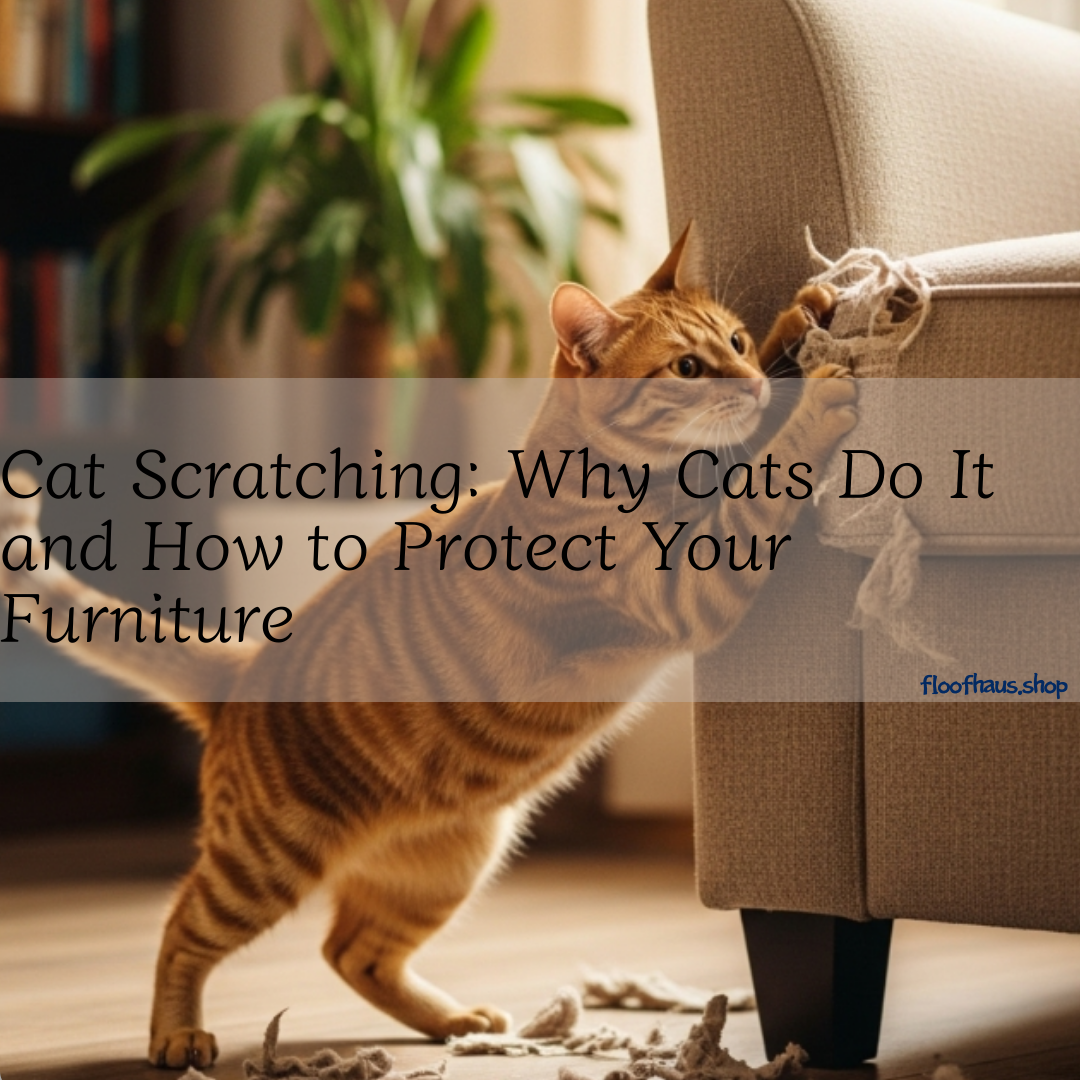
Cat Scratching: Why Cats Do It and How to Protect Your Furniture
Share

Introduction
Cat scratching is a behavior that nearly every cat parent will encounter. From shredded sofa arms to frayed carpets, it can sometimes feel like your feline companion has declared war on your furniture. But in reality, scratching is an instinctive and essential part of feline life. Rather than being a destructive habit, it serves important physical and emotional purposes. The challenge lies in teaching your cat where it’s appropriate to scratch while preserving your home.
Why Cats Scratch
Scratching is deeply ingrained in a cat’s instincts. Long before domestication, wild cats relied on scratching to maintain their claws, stretch their muscles, and mark their territory. Even though house cats have traded the forest for living rooms, those instincts remain strong.
When cats scratch, they:
- Sharpen and shed claws: Scratching helps remove the outer sheath of the claw, keeping nails healthy and sharp.
- Stretch muscles and tendons: It’s a full-body workout, giving them a chance to flex and relieve tension.
- Communicate territory: Cats have scent glands in their paws, so every scratch leaves both a visual and scent marker.
- Relieve stress: Scratching is a natural outlet for pent-up energy or anxiety.
Understanding that scratching is not about defiance but necessity is the first step toward managing it constructively.
Common Reasons
While scratching is instinctive, there are also specific reasons your cat may be targeting your couch instead of their scratching post.
-
Marking Territory
Cats are territorial creatures. Scratching communicates ownership, sending both visual and scent signals to other pets. -
Nail Health
Just like humans need nail care, cats need to shed the outer layers of their claws. If they don’t, nails may split or grow uncomfortably long. -
Stress and Anxiety
A big move, a new pet, or even changes in your daily routine can trigger stress-related scratching. -
Boredom or Lack of Enrichment
Cats that don’t get enough mental or physical stimulation often turn to scratching as a way to entertain themselves. -
Habit and Preference
Some cats simply develop preferences for certain textures—like leather couches or wooden chair legs—that mimic tree bark.
By identifying the cause, you can create more effective strategies to redirect the behavior.
The Downsides for Pet Parents
While scratching is perfectly healthy for cats, it can be a nightmare for pet parents. Common frustrations include:
- Torn upholstery and rugs.
- Scratched wooden furniture and door frames.
- The expense of repairing or replacing damaged household items.
- Stress and frustration that can strain the human-animal bond.
Fortunately, with patience and the right tools, these challenges are completely manageable.
How to Redirect Cat Scratching
Instead of trying to stop scratching altogether—which is impossible—it’s about providing alternatives. Here are proven strategies:
1. Offer Multiple Scratching Surfaces
Cats have individual preferences. Some like vertical posts, others prefer horizontal pads. Provide a variety: sisal-wrapped posts, cardboard scratchers, carpet mats, and wood options.
2. Strategic Placement
Place scratching posts near the areas your cat currently scratches—like next to the couch or in front of a doorway. Cats often scratch where they spend the most time.
3. Reward Good Behavior
When your cat uses the scratching post, offer praise, treats, or playtime. Positive reinforcement strengthens the habit.
4. Use Attractants
Catnip spray or silvervine powder can make scratching posts irresistible. Sprinkling a little can encourage consistent use.
5. Protect High-Risk Areas
Furniture covers, double-sided tape, or deterrent sprays can make your couch less appealing until your cat transitions to approved scratching areas.
Best Products for Solutions
Cat parents don’t have to navigate this issue alone—there are excellent products designed specifically to manage scratching.
-
Scratching Posts and Towers
Tall, sturdy posts wrapped in sisal rope or fabric are essentials. Multi-level towers double as climbing and scratching stations. -
Cardboard Scratchers
Affordable and portable, cardboard scratchers are great for cats who like horizontal scratching. They also allow for easy replacement when worn out. -
Deterrent Sprays
Safe sprays with citrus or herbal scents can discourage cats from targeting furniture. -
Furniture Protectors
Clear plastic or vinyl guards can protect sofa arms and chair legs during training. -
Nail Caps
Soft, non-toxic caps placed over claws prevent damage without harming the cat.
Investing in the right mix of products can turn scratching from a problem into a manageable routine.
What to Avoid
While dealing with scratching can be frustrating, some approaches can harm your cat or worsen the issue:
- Punishment: Yelling, squirting water, or physically reprimanding your cat only increases stress and may damage your relationship.
- Declawing: This surgical procedure removes part of a cat’s toes and is widely considered inhumane. It can cause lifelong pain and behavioral issues.
- Neglecting Nail Care: Skipping regular trimming can make scratching more destructive.
Instead, focus on redirection, enrichment, and consistent training.
Long-Term Management
Sustainable success comes from combining immediate fixes with long-term care.
- Routine Nail Trimming: Regular trims reduce sharpness and potential damage.
- Environmental Enrichment: Rotate toys, provide climbing structures, and engage in interactive play.
- Consistent Training: Redirecting your cat to appropriate scratching posts takes time and patience.
- Health Checkups: If scratching suddenly increases, consult a veterinarian to rule out underlying issues like stress, arthritis, or skin problems.
When scratching is managed as part of a holistic care plan, both cats and their humans benefit.
How Floofhaus Supports Cat Owners
At Floofhaus, we know that scratching can test your patience—but it doesn’t have to damage your bond with your cat or your furniture. That’s why we offer a carefully selected range of solutions, including:
- Durable scratching posts and towers.
- Eco-friendly cardboard scratchers.
- Safe deterrent sprays.
- Protective furniture covers.
- Gentle nail care tools.
Our goal is to help you create a home where your cat’s natural instincts can flourish—without sacrificing your favorite couch.
Conclusion
Scratching is not a bad habit—it’s an essential part of a cat’s life. By understanding why cats scratch and providing the right outlets, you can protect your furniture while supporting your cat’s health and happiness. With patience, training, and the right products, scratching becomes less of a battle and more of a balanced routine in your home.
Sources
- American Veterinary Medical Association (AVMA) – Scratching Behavior in Cats
- Humane Society of the United States – Cat Scratching Solutions
- International Cat Care – Understanding Cat Behavior
